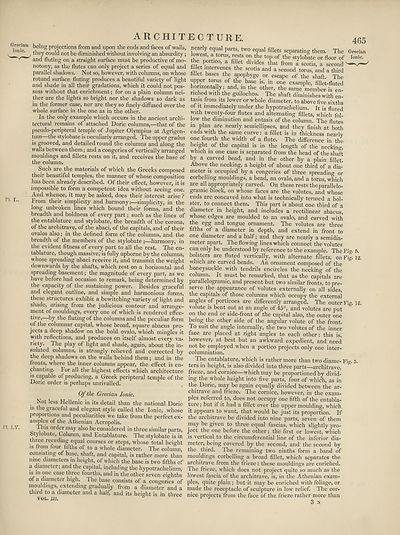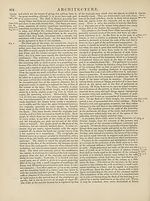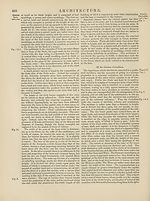Encyclopaedia Britannica > Volume 3, Anatomy-Astronomy
(473) Page 465
Download files
Complete book:
Individual page:
Thumbnail gallery: Grid view | List view

ARCHITECTURE.
ri. r..
^IoiRc n projections from and upon the ends and faces of walls,
j they could not be diminished without involving an absurdity ;
' and fluting on a straight surface must be productive of mo¬
notony, as the flutes can only project a series of equal and
parallel shadows. Not so, however, with columns, on whose
rotund surface fluting produces a beautiful variety of light
and shade in all their gradations, which it could not pos¬
sess without that enrichment; for on a plain column nei¬
ther are the lights so bright nor the shadows so dark as
in the former case, nor are they so finely diffused over the
whole surface in the one as in the other.
In the only example which occurs in the ancient archi¬
tectural remains of attached Doric columns,—that of the
pseudo-peripteral temple of Jupiter Olympius at Agrigen-
tum—the stylobate is rteculiarly arranged. The upper gradus
is grooved, and detailed round the columns and along the
walls between them; and a congeries of vertically arranged
mouldings and fillets rests on it, and receives the base of
the column.
Such are the materials of which the Greeks composed
their beautiful temples, the manner of whose composition
has been already described. Of their effect, however, it is
impossible to form a competent idea without seeing one.
And whence, it may be asked, does their interest arise ?
From their simplicity and harmony;—simplicity, in the
long unbroken lines which bound their forms, and the
breadth and boldness of every part; such as the lines of
the entablature and stylobate, the breadth of the corona,
of the architrave, of the abaci, of the capitals, and of their
ovalos also; in the defined form of the columns, and the
breadth of the members of the stylobate ;—harmony, in
the evident fitness of every part to all the rest. The en¬
tablature, though massive, is fully upborne by the columns,
whose spreading abaci receive it, and transmit the weight
downwards by the shafts, which rest on a horizontal and
spreading basement; the magnitude of every part, as we
have before had occasion to remark, being determined by
the capacity of the sustaining power. Besides graceful
and elegant outline, and simple and harmonious forms,
these structures exhibit a bewitching variety of light and
shade, arising from the judicious contour and arrange¬
ment of mouldings, every one of which is rendered effec¬
tive,—by the fluting of the columns and the peculiar form
of the columnar capital, whose broad, square abacus pro¬
jects a deep shadow on the bold ovalo, which mingles it
with reflections, and produces on itself almost every va¬
riety. The play of light and shade, again, about the in¬
sulated columns, is strongly relieved and corrected by
the deep shadows on the walls behind them; and in the
fronts, where the inner columns appear, the effect is en¬
chanting. For all the highest effects which architecture
is capable of producing, a Greek peripteral temple of the
Doric order is perhaps unrivalled.
Of the Grecian Ionic.
Not less Hellenic in its detail than the national Doric
is the graceful and elegant style called the Ionic, whose
proportions and peculiarities we take from the perfect ex¬
amples of the Athenian Acropolis.
D- • 1 his order may also be considered in three similar parts,
Stylobate, Column, and Entablature. The stylobate is in
three receding equal courses or steps, whose total height
is from four fifths of to a whole diameter. The column,
consisting of base, shaft, and capital, is rather more than
nine diameteis in height, of which the base is two fifths of
a diameter; and the capital, including the hypotrachelium,
is in one case three fourths, and in the other seven eighths
of a diameter high. I he base consists of a congeries of
mouldings, extending gradually from a diameter and a
third to a diameter and a half, and its height is in three
VOL. JUI.
465
Grecian
Ionic.
nearly equal parts, two equal fillets separating them. The
owest, a torus, rests on the top of the stylobate or floor of
the portico, a fillet divides that from a scotia, a second '
fi et intervenes the scotia and a second torus, and a third
tillet bases the apophyge or escape of the shaft. The
upper torus of the base is, in one example, fillet-fluted
horizontally; and, m the other, the same member is en¬
riched with the gmlochos. The shaft diminishes with en¬
tasis from its lower or whole diameter, to above five sixths
of it immediately under the hypotrachelium. It is fluted
with twenty-four flutes and alternating fillets, which fol¬
low the diminution and entasis of the column. The flutes
m plan are nearly semiellipses, and they finish at both
ends with the same curve: a fillet is in thickness nearly
one fourth the width of a flute. The difference in the
height of the capital is in the length of the necking,
which in one case is separated from the head of the shaft
by a carved bead, and in the other by a plain fillet.
Above the necking, a height of about one third of a dia¬
meter is occupied by a congeries of three spreading or
corbelling mouldings, a bead, an ovalo, and a torus, which
are all appropriately carved. On these rests theparallelo-
gramic block, on whose faces are the volutes, and whose
ends are concaved into what is technically termed a bol¬
ster, to connect them. This part is about one third of a
diameter in height, and includes a rectilinear abacus,
whose edges are moulded to an ovalo, and carved with
the egg and tongue ornament. The volutes are three
fifths of a diameter in depth, and extend in front to
one diameter and a half; and they are nearly a semidia¬
meter apart. The flowing lines which connect the volutes
can only be understood by reference to the example. The Fig. C.
bolsters are fluted vertically, with alternate fillets, on Fig. 12.
which are carved beads. An ornament composed of the
honeysuckle with tendrils encircles the necking of the
column. It must be remarked, that as the capitals are
parallelogramic, and present but two similar fronts, to pre¬
serve the appearance of volutes externally on all sides,
the capitals of those columns which occupy the external
angles of porticoes are differently arranged. The outer Fig. IS.
volute is bent out at an angle of 45°, and volutes are put *
on the end or side-front of the capital also, the outer one
being the other side of the angular volute of the front.
To suit the angle internally, the two volutes of the inner
face are placed at right angles to each other: this is,
however, at best but an awkward expedient, and need
not be employed when a portico projects only one inter-
columniation.
The entablature, which is rather more than two diame-Fig. 5.
ters in height, is also divided into three parts—architrave,
frieze, and cornice—which may be proportioned by divid¬
ing the whole height into five parts, four of which, as in
the Doric, may be again equally divided between the ar¬
chitrave and frieze. The cornice, however, in the exam¬
ples referred to, does not occupy one fifth of the entabla¬
ture; but if it had a fillet over the upper moulding, which
it appears to want, that would be just its proportion. If
the architrave be divided into nine parts, seven of them
may be given to three equal fascias, which slightly pro¬
ject the one before the other; the first or lowest, which
is vertical to the circumferential line of the inferior dia¬
meter, being covered by the second, and the second by
the third. The remaining two ninths form a band of
mouldings corbelling a broad fillet, which separates the
architrave from the frieze: these mouldings are enriched.
The frieze, which does not project quite so much as the
lowest fascia of the architrave, is, in the Athenian exam¬
ples, quite plain ; but it may be enriched with foliage, or
made the receptacle of sculpture in low relief. The cor¬
nice projects from the face of the frieze rather more than
3 N
ri. r..
^IoiRc n projections from and upon the ends and faces of walls,
j they could not be diminished without involving an absurdity ;
' and fluting on a straight surface must be productive of mo¬
notony, as the flutes can only project a series of equal and
parallel shadows. Not so, however, with columns, on whose
rotund surface fluting produces a beautiful variety of light
and shade in all their gradations, which it could not pos¬
sess without that enrichment; for on a plain column nei¬
ther are the lights so bright nor the shadows so dark as
in the former case, nor are they so finely diffused over the
whole surface in the one as in the other.
In the only example which occurs in the ancient archi¬
tectural remains of attached Doric columns,—that of the
pseudo-peripteral temple of Jupiter Olympius at Agrigen-
tum—the stylobate is rteculiarly arranged. The upper gradus
is grooved, and detailed round the columns and along the
walls between them; and a congeries of vertically arranged
mouldings and fillets rests on it, and receives the base of
the column.
Such are the materials of which the Greeks composed
their beautiful temples, the manner of whose composition
has been already described. Of their effect, however, it is
impossible to form a competent idea without seeing one.
And whence, it may be asked, does their interest arise ?
From their simplicity and harmony;—simplicity, in the
long unbroken lines which bound their forms, and the
breadth and boldness of every part; such as the lines of
the entablature and stylobate, the breadth of the corona,
of the architrave, of the abaci, of the capitals, and of their
ovalos also; in the defined form of the columns, and the
breadth of the members of the stylobate ;—harmony, in
the evident fitness of every part to all the rest. The en¬
tablature, though massive, is fully upborne by the columns,
whose spreading abaci receive it, and transmit the weight
downwards by the shafts, which rest on a horizontal and
spreading basement; the magnitude of every part, as we
have before had occasion to remark, being determined by
the capacity of the sustaining power. Besides graceful
and elegant outline, and simple and harmonious forms,
these structures exhibit a bewitching variety of light and
shade, arising from the judicious contour and arrange¬
ment of mouldings, every one of which is rendered effec¬
tive,—by the fluting of the columns and the peculiar form
of the columnar capital, whose broad, square abacus pro¬
jects a deep shadow on the bold ovalo, which mingles it
with reflections, and produces on itself almost every va¬
riety. The play of light and shade, again, about the in¬
sulated columns, is strongly relieved and corrected by
the deep shadows on the walls behind them; and in the
fronts, where the inner columns appear, the effect is en¬
chanting. For all the highest effects which architecture
is capable of producing, a Greek peripteral temple of the
Doric order is perhaps unrivalled.
Of the Grecian Ionic.
Not less Hellenic in its detail than the national Doric
is the graceful and elegant style called the Ionic, whose
proportions and peculiarities we take from the perfect ex¬
amples of the Athenian Acropolis.
D- • 1 his order may also be considered in three similar parts,
Stylobate, Column, and Entablature. The stylobate is in
three receding equal courses or steps, whose total height
is from four fifths of to a whole diameter. The column,
consisting of base, shaft, and capital, is rather more than
nine diameteis in height, of which the base is two fifths of
a diameter; and the capital, including the hypotrachelium,
is in one case three fourths, and in the other seven eighths
of a diameter high. I he base consists of a congeries of
mouldings, extending gradually from a diameter and a
third to a diameter and a half, and its height is in three
VOL. JUI.
465
Grecian
Ionic.
nearly equal parts, two equal fillets separating them. The
owest, a torus, rests on the top of the stylobate or floor of
the portico, a fillet divides that from a scotia, a second '
fi et intervenes the scotia and a second torus, and a third
tillet bases the apophyge or escape of the shaft. The
upper torus of the base is, in one example, fillet-fluted
horizontally; and, m the other, the same member is en¬
riched with the gmlochos. The shaft diminishes with en¬
tasis from its lower or whole diameter, to above five sixths
of it immediately under the hypotrachelium. It is fluted
with twenty-four flutes and alternating fillets, which fol¬
low the diminution and entasis of the column. The flutes
m plan are nearly semiellipses, and they finish at both
ends with the same curve: a fillet is in thickness nearly
one fourth the width of a flute. The difference in the
height of the capital is in the length of the necking,
which in one case is separated from the head of the shaft
by a carved bead, and in the other by a plain fillet.
Above the necking, a height of about one third of a dia¬
meter is occupied by a congeries of three spreading or
corbelling mouldings, a bead, an ovalo, and a torus, which
are all appropriately carved. On these rests theparallelo-
gramic block, on whose faces are the volutes, and whose
ends are concaved into what is technically termed a bol¬
ster, to connect them. This part is about one third of a
diameter in height, and includes a rectilinear abacus,
whose edges are moulded to an ovalo, and carved with
the egg and tongue ornament. The volutes are three
fifths of a diameter in depth, and extend in front to
one diameter and a half; and they are nearly a semidia¬
meter apart. The flowing lines which connect the volutes
can only be understood by reference to the example. The Fig. C.
bolsters are fluted vertically, with alternate fillets, on Fig. 12.
which are carved beads. An ornament composed of the
honeysuckle with tendrils encircles the necking of the
column. It must be remarked, that as the capitals are
parallelogramic, and present but two similar fronts, to pre¬
serve the appearance of volutes externally on all sides,
the capitals of those columns which occupy the external
angles of porticoes are differently arranged. The outer Fig. IS.
volute is bent out at an angle of 45°, and volutes are put *
on the end or side-front of the capital also, the outer one
being the other side of the angular volute of the front.
To suit the angle internally, the two volutes of the inner
face are placed at right angles to each other: this is,
however, at best but an awkward expedient, and need
not be employed when a portico projects only one inter-
columniation.
The entablature, which is rather more than two diame-Fig. 5.
ters in height, is also divided into three parts—architrave,
frieze, and cornice—which may be proportioned by divid¬
ing the whole height into five parts, four of which, as in
the Doric, may be again equally divided between the ar¬
chitrave and frieze. The cornice, however, in the exam¬
ples referred to, does not occupy one fifth of the entabla¬
ture; but if it had a fillet over the upper moulding, which
it appears to want, that would be just its proportion. If
the architrave be divided into nine parts, seven of them
may be given to three equal fascias, which slightly pro¬
ject the one before the other; the first or lowest, which
is vertical to the circumferential line of the inferior dia¬
meter, being covered by the second, and the second by
the third. The remaining two ninths form a band of
mouldings corbelling a broad fillet, which separates the
architrave from the frieze: these mouldings are enriched.
The frieze, which does not project quite so much as the
lowest fascia of the architrave, is, in the Athenian exam¬
ples, quite plain ; but it may be enriched with foliage, or
made the receptacle of sculpture in low relief. The cor¬
nice projects from the face of the frieze rather more than
3 N
Set display mode to:
![]() Universal Viewer |
Universal Viewer | ![]() Mirador |
Large image | Transcription
Mirador |
Large image | Transcription
Images and transcriptions on this page, including medium image downloads, may be used under the Creative Commons Attribution 4.0 International Licence unless otherwise stated. ![]()
| Encyclopaedia Britannica > Encyclopaedia Britannica > Volume 3, Anatomy-Astronomy > (473) Page 465 |
|---|
| Permanent URL | https://digital.nls.uk/193763497 |
|---|
| Attribution and copyright: |
|
|---|---|
| Shelfmark | EB.16 |
|---|---|
| Description | Ten editions of 'Encyclopaedia Britannica', issued from 1768-1903, in 231 volumes. Originally issued in 100 weekly parts (3 volumes) between 1768 and 1771 by publishers: Colin Macfarquhar and Andrew Bell (Edinburgh); editor: William Smellie: engraver: Andrew Bell. Expanded editions in the 19th century featured more volumes and contributions from leading experts in their fields. Managed and published in Edinburgh up to the 9th edition (25 volumes, from 1875-1889); the 10th edition (1902-1903) re-issued the 9th edition, with 11 supplementary volumes. |
|---|---|
| Additional NLS resources: |
|

